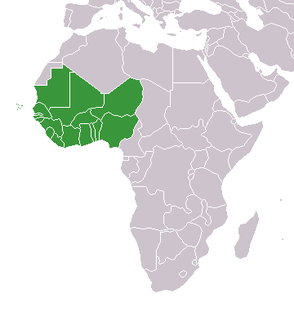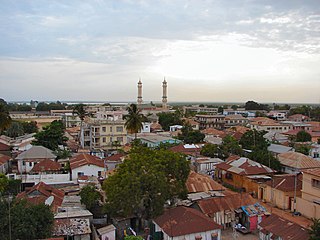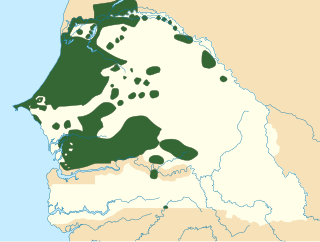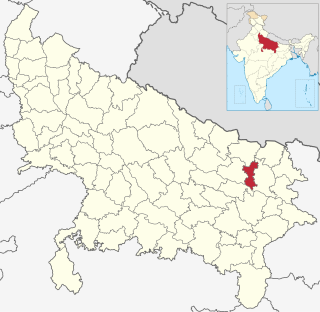
The Gambia, officially the Republic of the Gambia, is a country in West Africa. It is the smallest country within mainland Africa and is surrounded by Senegal, except for its western coast on the Atlantic Ocean. The Gambia is situated on both sides of the lower reaches of the Gambia River, the nation's namesake, which flows through the centre of the Gambia and empties into the Atlantic Ocean. It has an area of 10,689 square kilometres (4,127 sq mi) with a population of 1,857,181 as of the April 2013 census. Banjul is the Gambian capital and the country's largest metropolitan area. The largest cities are Serekunda and Brikama.

West Africa or Western Africa is the westernmost region of Africa. The United Nations defines Western Africa as the 17 countries of Benin, Burkina Faso, Cape Verde, The Gambia, Ghana, Guinea, Guinea-Bissau, Ivory Coast, Liberia, Mali, Mauritania, Niger, Nigeria, Senegal, Sierra Leone, and Togo as well as Saint Helena, Ascension and Tristan da Cunha. The population of West Africa is estimated at about 381 million people as of 2018, and at 381,981,000 as of 2017, of which 189,672,000 are female and 192,309,000 male.

The economy of the Gambia is heavily reliant on agriculture. The Gambia has no important mineral or other natural resources, and has a limited agricultural base. About 75% of the population depends on crops and livestock for its livelihood. Small-scale manufacturing activity features the processing of peanuts, fish, and animal hides.

Banjul, officially the City of Banjul, is the capital and fourth largest city of The Gambia. It is the centre of the eponymous administrative division which is home to an estimated 400,000 residents, making it The Gambia's largest and most densely populated metropolitan area. Banjul is on St Mary's Island, where the Gambia River enters the Atlantic Ocean. The population of the city proper is 31,301, with the Greater Banjul Area, which includes the City of Banjul and the Kanifing Municipal Council, at a population of 413,397. The island is connected to the mainland to the west and the rest of Greater Banjul Area via bridges. There are also ferries linking Banjul to the mainland at the other side of the river.
Telecommunications in the Gambia includes radio, television, fixed and mobile telephones, and the Internet.

The demographic characteristics of the population of the Gambia are known through national censuses, conducted in ten-year intervals and analyzed by The Gambian Bureau of Statistics (GBOS) since 1963. The latest census was conducted in 2013. The population of The Gambia at the 2013 census was 1.8 million. The population density is 176.1 per square kilometer, and the overall life expectancy in The Gambia is 64.1 years. Since the first census of 1963, the population of The Gambia has increased every ten years by an average of 43.2 percent. Since 1950s, the birth rate has constantly exceeded the death rate; the natural growth rate is positive. The Gambia is in the second stage of demographic transition. In terms of age structure, The Gambia is dominated by 15- to 64-year-old segment (57.6%). The median age of the population is 19.9 years, and the gender ratio of the total population is 0.98 males per female.

Wolof is a language of Senegal, the Gambia and Mauritania, and the native language of the Wolof people. Like the neighbouring languages Serer and Fula, it belongs to the Senegambian branch of the Niger–Congo language family. Unlike most other languages of the Niger-Congo family, Wolof is not a tonal language.

Sant Kabir Nagar district is one of the 75 districts of Uttar Pradesh state in northern India. Khalilabad city is the district headquarters. Sant Kabir Nagar district is a part of Basti division. The total area of Sant Kabir Nagar district is 1646 Sq. Km.

Chhatarpur District is a district of Madhya Pradesh state of central India. The town of Chhatarpur is the district headquarters.
The Catholic Church in the Gambia is part of the worldwide Catholic Church, under the spiritual leadership of the Pope in Rome. Gambia is a predominantly Muslim country. The Diocese of Banjul covers the whole of the country. Relations between the Muslim and Christian communities in Gambia are generally very good. The Catholic Church operates various missions including schools which children of Muslim parents attend. Of the minority Christian population, there are around 30,000 Catholics, which represents around 2% of the population.

The Gambia Football Federation (GFF), formerly known as the Gambia Football Association, is the governing body of football in Gambia. It was founded in 1952, and affiliated to FIFA in 1968 and to CAF in 1966. It organizes the GFA League First Division, the GFA League Second Division and the national team. The current president is Lamin Kaba Bajo since September 2014.

The Gambia is divided into five administrative Regions and one City. The divisions of the Gambia are created by the Independent Electoral Commission in accordance to Article 192 of the National Constitution.

The Commonwealth of Nations is a voluntary association of 54 sovereign states. Nearly all of them are former British colonies or dependencies of those colonies.

The following outline is provided as an overview of and topical guide to the Gambia:

Muslims constitute 96 percent of the population of the Gambia according to the CIA World Factbook, making Gambia a Muslim majority country. The vast majority are Sufi Sunnis influenced with Sufism, of which the main orders represented are Tijaniyah, Qadiriyah. Except for Ahmadiyya, Sufi orders pray together at common mosques. A small percentage of Muslims, predominantly immigrants from South Asia, do not ascribe to any traditional Islamic school of thought.

Gunjur is a small coastal town in south-western Gambia. It is located in Kombo South District in the Western Division. As of 2009, it has an estimated population of 17,520.

Christians in the Gambia constitute approximately 3 percent (~136,400) of the country's population
Public expenditure on health in the Gambia was at 1.8% of the GDP in 2004, whereas private expenditure was at 5.0%. There were 11 physicians per 100,000 persons in the early 2000s. Life expectancy at birth was 59.9 for females in 2005 and for males 57.7.
Gambian Sign Language is a national sign language used in Gambia by the deaf community there. The only school for deaf children in the Gambia, St John's School for the Deaf, was set up by a Catholic priest from Ireland. Dutch Sign Language was introduced to the school along with British Sign Language which developed into Gambian Sign Language, incorporating some indigenous gestures used by the general population. Unlike much of West Africa, American Sign Language was not introduced to the Gambia until much later so the deaf community is not familiar with American Sign Language.
The Gambian Creole people, or Krio or Aku, are a minority ethnic group of Gambia with connections to and some roots from the Sierra Leone Creole people. In Gambia the Aku account for about 2% of the population. Some estimates put the figure higher. However, according to the 2013 Gambian Census, the Aku make up 0.5% of the population or around 8,477 people.













